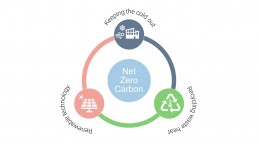Energy saving through Retrofit
Sarah Small
Over the last few years there seems to have been an increased awareness of climate change and the environment, this together with the Government’s 2050 Net Zero CO2 emissions target has led our industry to consider new ways to make buildings more efficient, less reliant on fossil fuels, and promote renewable technologies. The current energy crisis due to soaring fuel costs is also making us more mindful about where our energy is coming from and the need to be less wasteful with it.
Can green buildings work for us to solve this issue?
Incorporating technologies into new build has become common place for most sectors, with the most efficient method of creating new ‘green buildings’ being to utilise the three steps below.

Keep the cold out
Using modern methods of construction focusing on a highly insulated and airtight envelope ensures that heat is retained and prevented from escaping, therefore minimising the need for additional space heating.
Recycling waste heat
Waste heat recovery systems, including Mechanical Ventilation and Heat Recovery (MVHR) and waste-water heat recovery technologies ensure that waste heat is recycled, providing warmth to fresh air reducing the energy demand for heating.
Renewable technology
Finally using renewable technologies such as Solar Panels, Solar Thermal and Heat Pumps can generate energy, store it and even sell it back to the grid in some cases.
The upfront costs of building this way can be greater than traditional constructions, however the technology used can create savings over time which outweigh the initial outlay. The technologies are continually reducing in cost as they become ever more mainstream.
So new buildings can benefit from this type of approach but what about existing buildings?
Existing commercial, industrial, and institutional buildings can benefit substantially from the same ethos employed above and also carry the benefit of utilising their existing building structure, retaining all the embodied carbon and the savings that come with it.
This type of upgrade to an existing building is referred to as a Retrofit and a key part of the design is to employ a whole building approach. This is a holistic assessment of the entire building fabric in conjunction with a specialist Energy Consultant who will thermally model the building to identity and highlight the key areas to be targeted.
Replacing existing heating systems with renewables, swapping old lighting to LED fittings, improving the thermal performance of the external envelope, and introducing solar technologies will all contribute toward targeting Net Zero Carbon.
There are differing levels of Retrofit from a light touch to much deeper approach and each offers vary degrees of benefit Vs cost. It is worth noting that some existing buildings will not be suitable for Retrofit due to their age or construction, so not every project is suitable. The detail of the design and installation is key to ensure they work in harmony together, and it’s critical that projects are both designed and installed by professionals.
Putting theory into practice – Beaucroft College Wimborne
BoonBrown have been working recently with a team of consultants on a Retrofit project for a Special Educational Needs or Disability (SEND) facility in Wimborne, Dorset on behalf of Dorset Council. The project will be one of the first in Dorset to benefit from SALIX funding which is a government backed scheme to provide public sector projects with funding to reduce carbon emissions, lower bills and improve energy efficiency.
The site is the former Wimborne First School which consists of a group of buildings with notable architectural merit, unfortunately the buildings have been vacant for several years. Parts of the school are over 100 years old and have been subject to several adaptions over its life. The buildings have a number of the original features which are considered important to the setting of Wimborne and need to be retained.
A thorough assessment and survey of the existing building was undertaken to understand the existing structure, materials, and fittings. We worked with an Energy Consultant to identify the most cost effective and beneficial Retrofit adaptions for the building, which included the three steps we outlined above.
Keeping the cold out
The Retrofit follows a whole building design strategy with a fabric first approach which aims to exceed the current building regulation standards. This consists of thermally upgrading the accessible external fabric of the buildings, increasing air tightness, and replacing the existing single glazed doors and windows with double glazed units.
Recycling waste heat
New heat recovery units (MVHR) within the classrooms will increase the amount of fresh warm air in the buildings, improve internal comfort levels while providing excellent ventilation.
Renewable technologies
The existing heating system is a very inefficient gas boiler which is not fit for modern purposes. This is to be replaced with an extremely efficient air source heat pump and solar voltaic panels placed on each of the south facing roofs which will reduce energy bills and help further reduce C02 emissions.
It has been calculated that retrofitting the existing buildings to current building regulation standards will reduce C02 emissions by approximately 77%.
As with the new build route, the key to making this type of refurbishment work is ensuring the details of each inclusion and system is designed and installed correctly so everything works harmoniously. Crucial to this is that the works on site are carried out by skilled contractors and that the technical detailing is followed to ensure the benefits of the Retrofit method are realised.


